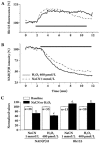Hydrogen peroxide mobilizes Ca2+ through two distinct mechanisms in rat hepatocytes
- PMID: 19079290
- PMCID: PMC4006535
- DOI: 10.1038/aps.2008.4
Hydrogen peroxide mobilizes Ca2+ through two distinct mechanisms in rat hepatocytes
Abstract
Aim: Hydrogen peroxide (H2O2) is produced during liver transplantation. Ischemia/reperfusion induces oxidation and causes intracellular Ca2+ overload, which harms liver cells. Our goal was to determine the precise mechanisms of these processes.
Methods: Hepatocytes were extracted from rats. Intracellular Ca2+ concentrations ([Ca2+](i)), inner mitochondrial membrane potentials and NAD(P)H levels were measured using fluorescence imaging. Phospholipase C (PLC) activity was detected using exogenous PIP2. ATP concentrations were measured using the luciferin-luciferase method. Patch-clamp recordings were performed to evaluate membrane currents.
Results: H2O2 increased intracellular Ca2+ concentrations ([Ca2+](i)) across two kinetic phases. A low concentration (400 micromol/L) of H2O2 induced a sustained elevation of [Ca2+](i) that was reversed by removing extracellular Ca2+. H2O2 increased membrane currents consistent with intracellular ATP concentrations. The non-selective ATP-sensitive cation channel blocker amiloride inhibited H2O2-induced membrane current increases and [Ca2+](i) elevation. A high concentration (1 mmol/L)of H2O2 induced an additional transient elevation of [Ca2+](i), which was abolished by the specific PLC blocker U73122 but was not eliminated by removal of extracellular Ca2+. PLC activity was increased by 1 mmol/L H2O2 but not by 400 micromol/L H2O2.
Conclusions: H2O2 mobilizes Ca2+ through two distinct mechanisms. In one, 400 micromol/L H2O2-induced sustained [Ca2+](i) elevation is mediated via a Ca2+ influx mechanism, under which H2O2 impairs mitochondrial function via oxidative stress,reduces intracellular ATP production, and in turn opens ATP-sensitive, non-specific cation channels, leading to Ca2+ influx.In contrast, 1 mmol/L H2O2-induced transient elevation of [Ca2+](i) is mediated via activation of the PLC signaling pathway and subsequently, by mobilization of Ca2+ from intracellular Ca2+ stores.
Figures








Similar articles
-
Mechanisms of Ca2+ overload induced by extracellular H2O2 in quiescent isolated rat cardiomyocytes.Basic Res Cardiol. 2001 Nov;96(6):623-9. doi: 10.1007/s003950170014. Basic Res Cardiol. 2001. PMID: 11770081
-
Hydrogen peroxide, potassium currents, and membrane potential in human endothelial cells.Circulation. 1999 Apr 6;99(13):1719-25. doi: 10.1161/01.cir.99.13.1719. Circulation. 1999. PMID: 10190882
-
Dose-dependent effect of hydrogen peroxide on calcium mobilization in mouse pancreatic acinar cells.Biochem Cell Biol. 2006 Feb;84(1):39-48. doi: 10.1139/o05-150. Biochem Cell Biol. 2006. PMID: 16462888
-
Hydrogen peroxide-induced Ca2+ mobilization in pulmonary arterial smooth muscle cells.Am J Physiol Lung Cell Mol Physiol. 2007 Jun;292(6):L1598-608. doi: 10.1152/ajplung.00323.2006. Epub 2007 Mar 16. Am J Physiol Lung Cell Mol Physiol. 2007. PMID: 17369291
-
Calcium sequestering ability of mitochondria modulates influx of calcium through glutamate receptor channel.Neurochem Res. 2000 Dec;25(12):1527-36. doi: 10.1023/a:1026602100160. Neurochem Res. 2000. PMID: 11152381
Cited by
-
Resveratrol attenuates the Na(+)-dependent intracellular Ca(2+) overload by inhibiting H(2)O(2)-induced increase in late sodium current in ventricular myocytes.PLoS One. 2012;7(12):e51358. doi: 10.1371/journal.pone.0051358. Epub 2012 Dec 13. PLoS One. 2012. PMID: 23272101 Free PMC article.
-
PKCα and HMGB1 antagonistically control hydrogen peroxide-induced poly-ADP-ribose formation.Nucleic Acids Res. 2016 Sep 19;44(16):7630-45. doi: 10.1093/nar/gkw442. Epub 2016 May 19. Nucleic Acids Res. 2016. PMID: 27198223 Free PMC article.
-
Potent effects of flavonoid-rich extract from Rosa laevigata Michx fruit against hydrogen peroxide-induced damage in PC12 cells via attenuation of oxidative stress, inflammation and apoptosis.Molecules. 2014 Aug 7;19(8):11816-32. doi: 10.3390/molecules190811816. Molecules. 2014. PMID: 25105919 Free PMC article.
-
Study of the protective effect of ischemic and pharmacological preconditioning on hepatic ischemic reperfusion injury induced in rats.JGH Open. 2017 Nov 14;1(3):105-111. doi: 10.1002/jgh3.12018. eCollection 2017 Nov. JGH Open. 2017. PMID: 30483545 Free PMC article.
-
HMGB1 release by H2O2-induced hepatocytes is regulated through calcium overload and 58-F interference.Cell Death Discov. 2017 Apr 10;3:17008. doi: 10.1038/cddiscovery.2017.8. eCollection 2017. Cell Death Discov. 2017. PMID: 28417016 Free PMC article.
References
-
- Bzeizi KI, Dawkes R, Dodd NJ, Plevris JN, Hayes PC. Graft dysfunction following liver transplantation: role of free radicals. J Hepatol. 1997;26:69–74. - PubMed
-
- Jaeschke H. Mechanisms of liver injury. II. Mechanisms of neutrophil-induced liver cell injury during hepatic ischemia-reperfusion and other acute inflammatory conditions. Am J Physiol Gastrointest Liver Physiol. 2006;290:G1083–8. - PubMed
-
- Rosser BG, Gores GJ. Liver cell necrosis: cellular mechanisms and clinical implications. Gastroenterology. 1995;108:252–75. - PubMed
-
- Rychkov G, Brereton HM, Harland ML, Barritt GJ. Plasma membrane Ca2+ release-activated Ca2+ channels with a high selectivity for Ca2+ identified by patch-clamp recording in rat liver cells. Hepatology. 2001;33:938–47. - PubMed
-
- Hoffman JW, Jr, Gilbert TB, Poston RS, Silldorff EP. Myocardial reperfusion injury: etiology, mechanisms, and therapies. J Extra Corpor Technol. 2004;36:391–411. - PubMed
Publication types
MeSH terms
Substances
LinkOut - more resources
Full Text Sources
Miscellaneous

